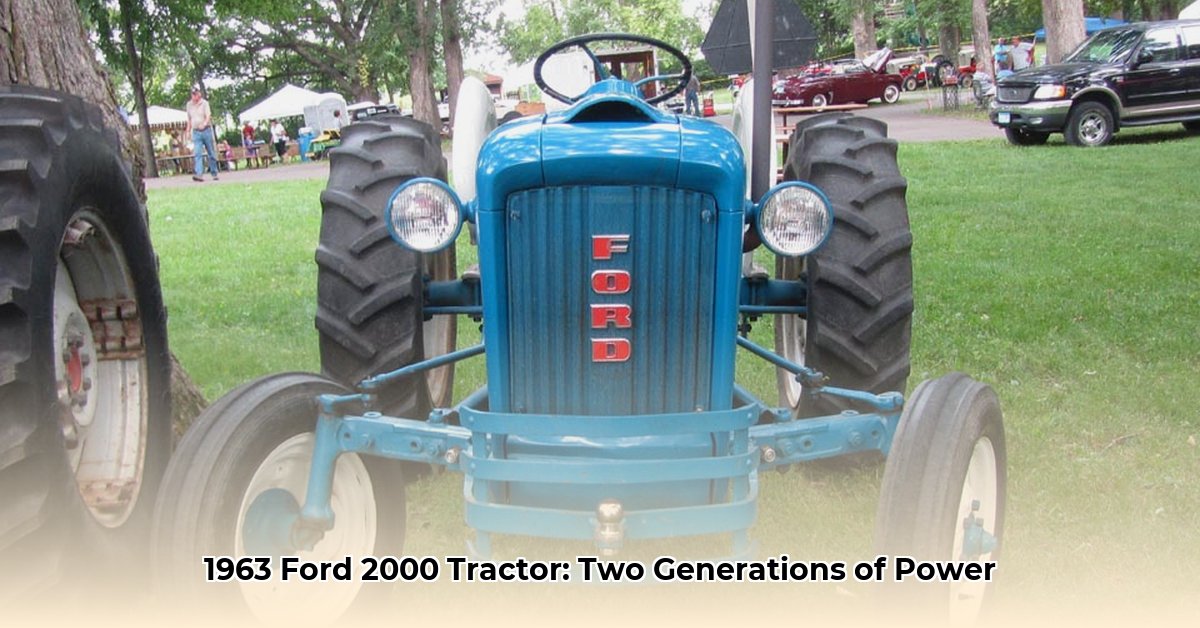
Understanding the Ford 2000's Dual Legacy
The Ford 2000 tractor, a stalwart of agricultural history, exists in two distinct forms, each reflecting the evolving needs and technological advancements of its time. This article delves into the key differences between these generations, highlighting their technical specifications and implications for farmers and collectors alike. Understanding these nuances is crucial, whether you're aiming for a restoration project or seeking a robust, vintage tractor for sustainable farming practices. For more on Ford tractors, check out this helpful resource: Ford tractor history.
Under the Hood: Engine Power and Fuel Efficiency
The most striking difference lies in the engine. The initial 1963 Ford 2000 featured a robust four-cylinder engine, delivering a substantial 48.4 gross horsepower. This provided ample power for a wide range of tasks. However, a subsequent iteration transitioned to a three-cylinder engine, generating a more modest 39 horsepower. While seemingly a decrease in power, this change prioritized fuel efficiency—a critical factor for farmers facing fluctuating fuel costs. This shift reflects the economic realities shaping agricultural practices in the mid-20th century.
Did this fuel efficiency trade-off ultimately benefit farmers? The answer, as we will explore, is nuanced and depended heavily on individual farming needs and operational contexts.
Transmission Variations: Adapting to Farming Demands
Both generations offered a variety of transmission options, catering to diverse farming needs. The four-cylinder model boasted 4, 5, 10, and even 12-speed transmissions, providing flexibility for various tasks. The three-cylinder model, conversely, presented options of 4, 6, and 8-speed transmissions, as well as a 12-speed unsynchronized version. The availability of different transmission options catered to farmers' preferences and the specific demands of their operations.
What was the practical impact of these transmission differences? The additional gears on higher-speed transmissions offered versatility to farmers constantly switching between different tools, while those with less demanding operations found the simpler setups perfectly adequate.
Hydraulic Performance: Powering Implements Efficiently
The hydraulic systems, while both open-center, exhibited key distinctions. The four-cylinder model delivered a hydraulic pressure of 2000 psi, while the three-cylinder model improved upon this with 2500 psi. Higher pressure directly translated to a more powerful lift capacity, enhancing the performance of hydraulically operated implements like plows and loaders. Furthermore, the three-cylinder version boasted a significantly larger hydraulic fluid reservoir (6.3 gallons versus 2 gallons), suggesting a focus on extending maintenance intervals and reducing operational downtime.
How did these hydraulic differences contribute to overall operational efficiency? The larger reservoir, in particular, contributed to lower maintenance costs and a streamlined workflow for farmers.
Weight and Traction: Navigating Diverse Terrain
Weight considerations also differentiated the two generations. The four-cylinder model weighed between 3020 and 3362 pounds, while the three-cylinder variant ranged from 3280 to 4100 pounds, showcasing a noticeable weight increase. This extra weight in the three-cylinder model likely improved traction, particularly in challenging conditions like mud or uneven terrain. However, it may have also slightly reduced maneuverability in certain situations. The optimal weight, therefore, remained highly dependent on the specific farming environment and the types of tasks undertaken.
Was the increased weight of the three-cylinder model always advantageous? This is a question farmers faced, balancing superior traction with potential trade-offs in maneuverability.
Comparative Analysis: Key Specifications at a Glance
| Feature | Four-Cylinder Model | Three-Cylinder Model |
|---|---|---|
| Engine | Four-cylinder, 48.4 hp (gross) | Three-Cylinder, 39 hp |
| Transmission | 4, 5, 10, or 12-speed | 4, 6, 8, or 12-speed (unsynchronized) |
| Hydraulic Pressure | 2000 psi | 2500 psi |
| Hydraulic Reservoir | 2 gallons | 6.3 gallons |
| Weight | 3020-3362 lbs | 3280-4100 lbs |
| Fuel Tank | 13 gallons | 13 gallons |
The Enduring Legacy of the Ford 2000
Both generations of the Ford 2000 established a robust legacy within the agricultural world. They provided reliable power and enduring performance for a wide range of farming operations. The evolution from the four-cylinder to the three-cylinder model showcases an adaptation to market demands, specifically addressing fuel economy and manufacturing costs. Beyond their technical specifications, these tractors embody a specific era in agricultural history—a time defined by strength, hard work, and a pioneering spirit. Further research could shed light on production numbers and regional variations in the tractor's availability and use.
Ford 2000 and Sustainable Farming Practices
Choosing between the two generations of Ford 2000 tractors requires careful consideration, especially for those prioritizing sustainable farming. Fuel efficiency, longevity, and ease of maintenance all play a significant role.
"The three-cylinder Ford 2000, while less powerful, often proves more economical in the long run," notes Dr. Amelia Hernandez, Agricultural Engineering Professor at the University of California, Davis. "Its reduced fuel consumption contributes to lower operating costs and a smaller environmental footprint."
This aligns with the core principles of sustainability: minimizing resource depletion and reducing environmental impact. Therefore, a thorough assessment of individual needs and operational contexts remains critical in determining the most appropriate Ford 2000 model.